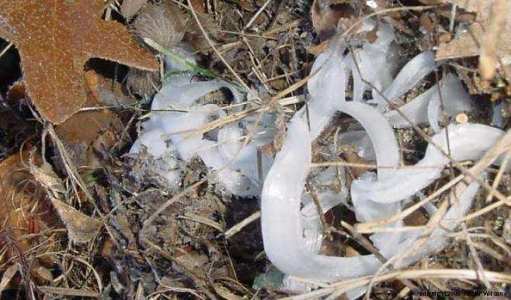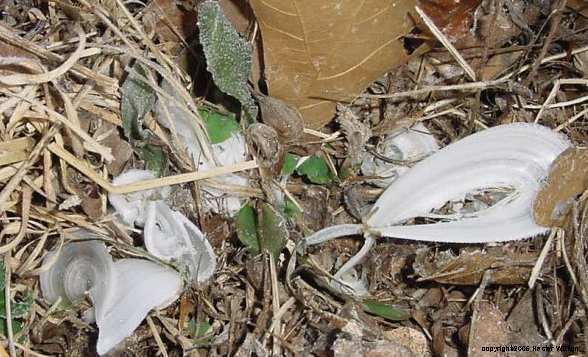 |
 |
| Home | Welcome | What's New | Site Map | Glossary | Weather Doctor Amazon Store | Book Store | Accolades | Email Us |
 | |||||||||
Weather Almanac for February 2005FROST FLOWERS AND ICE RIBBONSHigh on my "why I love weather" list is the realization that, after half a century of weather watching, the weather still can surprise me. Not only in how the forces of weather combine to give new experiences but also how they interact with the rest of nature to give new visages and beauty. Over the past few months, questions from my readers concerning a phenomenon they observed revealed something completely new to me. One query came from Hester Reinacker. Another, a few weeks later, came from Hester Wilson of Missouri. (An odd coincidence, two emails from a woman named Hester on the same topic — which cofused me for a time.) Sho wrote: "We're getting some kind of frost that doesn't look like either rime or hoar frost. It appears every morning in the same exact areas (scattered spots), and melts during the day. It resembles ribbons of Christmas candy, some only attached to the ground at its base." 
No strict definitions for the phenomena have yet been established, and the amount of information on exactly where and how they form is sparse. The following material is gleaned from several sources: engineer Forest M. Mims III, ecologist D. Bruce Means, and geographer James R. Carter. Mims describes frost flower as "extraordinarily delicate ribbons and whorls of ice that surround the stems of certain plants when the temperature falls below freezing." He notes that they are also called frost or ice castles. Means remarks that: "Ice flowers can be as small as a Ping-Pong ball or as large as a grapefruit." Carter wrote: "There is no standardization of terms. While one person calls these ice flowers, another person uses that same term to apply to something different. I prefer ice ribbons, based on their form." I think the name ice ribbons best fits the photographs I have seen, though ice ribbon has also been used to describe a type of icicle that clings to rock faces where ground water seeps through cracks in the rock. Frost Flowers and VegetationWhile these frost flowers are not actual flowers (and strictly speaking they are not frost, either), they are linked to vegetation. Those presented in the accompanying photographs arise from the dead stems of plants. The above observers suggest frost flower formation may prefer certain species. These include: white crownbeard (Verbesina virginica), yellow ironweed (Verbesina alternifolia), frostweed (Helianthemum canadense), wild oregano (Cunila origanoides) and mountain dittany (Cunila mariani). With the study of frost flowers in its infancy, I would not be surprised to see other plant species included in the list as time goes on.  Frost Flower FormationThose who have looked closely at these ice formations appear to agree on a basic model for their appearance and growth. Carter's web page summarizes the state of understanding on the topic, and the following is a condensation of his report. An ice flower emerges from the dead stems of the plant. It appears that the water, or perhaps a sap, within the stem may have frozen, causing the stem tissue to burst, like a frozen water pipe, and allowing the water or the ice to extrude outward. As the moisture within the stem freezes, it pushes outward like toothpaste from the tube, thus forming the ribbon-like pattern common to many of these formations. And as it extrudes, the ribbon may curl and loop as gravity and other forces affect the process.
Carter writes: "The presence of the striations in these diaphanous ribbons of ice tell us they had to be extruded as a plastic form of ice — something more solid than liquid. They are solid enough that they form continuous, unbroken ribbons many inches in length. They are plastic enough that they can be extruded. It is likely that the ribbons freeze solid once they enter into the open air." The leading edge of the extrusion freezes to the stem's papery bark as it emerges, and as the ribbon pushes outward, it is lifted upward by the attached bark. Carter notes that the ice structure emerges from a very narrow rupture in the stem, measuring some 5 to 10 cm (2 to 4 inches) in length. The narrowness of the fissure causes the ice to extrude as a ribbon rather than an cylinder. He speculates that the water used to form the ice likely flowed from the warmer soil below up the stem. He then asks "What is the process that brings water, or forces water, up into a stem and forces it to be extruded out as a thin sheet of ice?" Perhaps the driving force is a capillary action similar to that which draws soil water up in the living plant or a driving gradient force caused by the conversion of water to ice. And, given that only certain species appear to form frost flowers, the stem physiology of these species may play an important role. (Otherwise, all woody weeds in the area would form them.) The size of frost flowers appears to be about that of a hand or oak leaf, and the ribbon is uniform in size and quite delicate. Parallel ridges within the ribbon likely indicate surges of growth, much like the rings found in icicles. Carter photographed one ribbon piece in his colleague's hand, and the skin was visible through the ribbon. Because of their thinness and delicate nature, they may quickly melt if the temperatures rise above freezing during the day or perhaps quickly sublime in the dry air. Solar heat is undoubtably destructive to frost flowers and thus most are found in shaded spots. Where and When To LookTo define a "season" for ice flowers is not strictly possible and it likely varies with the region of the continent just as the blooming of real flowers changes with geography and terrain, likely moving southward later in the year (or early in the new year). My instinctive belief is that they can form whenever temperatures drop well below freezing in the ground-level microlayer of atmosphere over a soil that is quite moist and likely not frozen deep enough to lock up the moisture in the soil. Perhaps in the colder climes such as much of Canada, the movement of frost into the soil is too fast, and the moisture locks up as ice. In addition, when the ground becomes snow-covered, any frost flowers would be hidden from view.
Based on the reports found on-line, frost flowers appear to be more common in the southern United States or states bordering that region: Missouri, southern Illinois, east Tennessee, southern Ohio, West Virginia, Arkansas, north Florida, Oklahoma and Texas, although D. S. Libbey observed them in Crater Lake National Park, Oregon. I am convinced their occurrence is more widespread than the above list of states indicates and that they likely occur in Canada as well but just haven't been reported. Low elevation regions of Vancouver Island and the south coast of British Columbia (as well as regions of Washington State and Oregon as Libbey's discovery has shown) have a thermal climate where soil freezing is often shallow and soil water is high so perhaps they lay hidden there awaiting a sharp eye. Pockets of my memory hint that I may have seen frost flowers from afar and failed to recognize them for what they were. I will have to take some forest trail walks when weather conditions are conducive to their formation. If any of you have observed these delicate phenomena, I'd be happy to hear from you. Addendum 2006: Frost RibbonsThat last sentence in the second paragraph up has now been confirmed. This past week I received an email with two amazing pictures from Sheryl Terris on Vancouver Island. In her email, she wrote: "I have been getting these ice formations on my gate now year after year and never thought much about it until someone asked me and I couldn't even tell her what they are called. She did some research and found this site that your article was on. I thought I would send you a couple of pics and also let you know that these are "growing" on my metal front gate not out of the ground that are in your pictures. I live on Vancouver Island in BC Canada which is a fairly moist climate, it's about -5oC (23oF) when these start to form. "
As interesting as the location of occurrence is that they "grew" out of a metal fence rail rather than the stem of a ground plant. I looked closely at the photos and deduced that they fit very well into the mechanism suggested by Professor Carter, yet formed on metal instead of a plant part. I surmised the metal bars are hollow, which she confirmed. Given the heavy fall rains on the Island, it is quite reasonable to assume enough seeps into the fence crossbar to provide the source for the ice water.If so, the water in the crossbar, on freezing, extrudes from a small crack in its surface — a rusty spot most likely (also confirmed my Sheryl). In doing so, a frost ribbon is formed. Addenda 2008, 2009: Making Frost RibbonsI have heard again from Professor Emeritus James Carter. He has spent time this past winter making ice ribbons similar to those found by Sheryl Terris. You can find the results of his work at: All frost flower photographs ©2005 Hester Wilson, all rights reserved. Used by permission of Hester Wilson. Frost ribbon photographs ©2006 Sheryl Terris, all rights reserved. Used by permission of Sheryl Terris.Written by
|
 |
To Purchase Notecard, |


